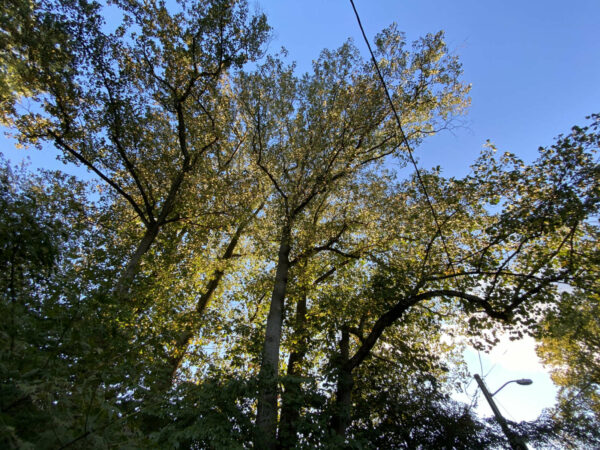
EcoAction Arlington just got a $60,000 boost from the Arlington branch of the NAACP and the Mormon church in its efforts to plant trees in disadvantaged neighborhoods.
Last year, the environmental advocacy group announced its plan to plant trees in 10 neighborhoods where the canopy is thinner than elsewhere — areas generally less wealthy and more diverse than Arlington’s leafier enclaves. The 2022 announcement coincided with a $50,000 donation from Amazon.
The initiative, dubbed the Tree Canopy Equity program, aims to raise $1.5 million to fund planting 250 trees twice a year, for the next five years — or 2,500 trees total. Last week, the NAACP announced it had selected EcoAction Arlington to receive the money through a strategic grant and partnership with The Church of Jesus Christ of Latter-day Saints.
“Arlington has a 10-year life expectancy difference amongst its neighborhoods, and this donation will create focus and provide much-needed tree canopy in places that have, for decades, been left out of the conversation,” NAACP Branch President Michael Hemminger said in a statement. “For years, EcoAction Arlington has been a committed partner in the furtherance of our mission, making them a natural fit for why we selected this non-profit as the recipient.”
To date, EcoAction Arlington has raised $239,000 from individuals, corporations, nonprofits, foundations and the state of Virginia, executive director Elenor Hodges tells ARLnow.
“That’s got to be a record for us in most money raised in shortest amount of time,” she said. “We’re truly grateful to the NAACP and looking to them as a true partner.”
The money funds outreach needed to find residents, apartment buildings and organizations interested in planting trees. It also pays for shrubs — trees are paid for through the Arlington County Tree Canopy Fund — and, in some cases, water.
Hodges says she is excited to use support from a foundation to pay community members to do the outreach work, similar to a model used in Wards 7 and 8 in D.C.
“This community work takes people, time and money, so we want to pay people and professionalize it,” she said.
This spring, volunteers planted 215 trees and 110 shrubs across the 10 neighborhoods, particularly in Penrose, Green Valley and Aurora Highlands, she said. Shrubs provide the benefits of trees and are ideal for people without the space for a tree or who are not ready to add one to their yard.
The 10 neighborhoods being targeted have a lower average tree canopy than Arlington County as a whole, according to one study funded by some members of local environmental advocacy groups, including EcoAction Arlington.
Based on imaging from 2021, a consultant found that trees cover 33% of land — excluding the Pentagon and Reagan National Airport — down from 41% on the same land six years ago. The 10 neighborhoods, meanwhile, have a canopy coverage average of 22.6%.
The neighborhoods and their canopy levels are as follows:
- Arlington View, 17%
- Aurora Highlands, 22%
- Buckingham, 21%
- Columbia Heights, 28%
- Glebewood, 29%
- Green Valley, 24%
- John M. Langston Citizens Association, 19%
- Long Branch Creek, 24%
- Penrose, 23%
- Radnor/Fort Myer Heights, 19%
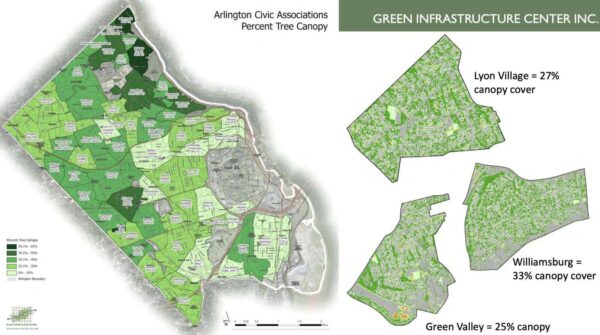
The absence of trees makes a neighborhood hotter and Arlington’s hottest places are along the Rosslyn-Ballston corridor and near Reagan National Airport, per a study by Marymount University.
Study authors say this is because concrete and asphalt absorb heat and radiate it back into the environment while neighborhoods in North Arlington have more trees and gardens to soak up that sunshine.
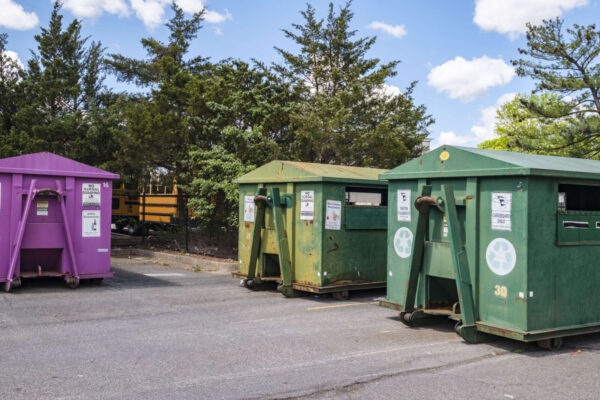
Arlington’s recycling rate is trending up — but there is still a ways to go to reach the county’s goal of diverting nearly all trash from incinerators and landfills by 2038.
In 2021, the recycling rate, which now includes the county’s new food scrap collection program, was 52.4%, according to Solid Waste Bureau Chief Erik Grabowsky. Last year’s rate is projected to be 54%.
The county’s recycling rate has risen incrementally in the last six years, from 44.5% in 2015. But residents and the government will have to double down on food scrap collection and recycling, while reducing overall waste, over the next 15 years if the county is supposed to reach its goal of diverting 90% of trash from incineration and landfills by 2038.
Grabowsky says greater participation in the county’s food scraps collection program and improved recycling habits would get the county halfway there.
“If we do a much better job of recycling and a much better job of food scrap collection, we get into the mid-to-high 70th percentile,” he said in a February meeting. “Beyond 75%, it’s a real challenge.”
To close that 15% gap, county staff, a Solid Waste Committee and local environmentalists have several ideas, including promoting reusable dishware in Arlington Public Schools and starting collections for hard-to-recycle items.
These and other ideas could be incorporated into a forthcoming Solid Waste Management Plan to replace the current one approved in 2004. This road map, which could be ready for public engagement this summer, will guide the county’s approach to waste management and could include interim milestones to make a 90% diversion rate seem manageable: a 60% diversion rate by 2028 and 75% rate by 2033.
Solid Waste Committee Chair Carrie Thompson says she likes to think of this plan as a “Zero Waste Plan,” the most important objective of which is getting all Arlingtonians on board with producing less trash.
“We’re all in this together,” Thompson tells ARLnow. “We have to be conscientious because the county can only do so much… If we all do better about what hits the bins, then what they do is more effective.”
For instance, food scraps and compostable paper comprised 26-32% of what went into the trash last year, while recyclable paper products and glass comprised about 14-16% of trash, according to data provided to ARLnow. Since 2019, residents have been asked to recycle glass separately to improve recycling quality and save the county money.
Conversely, trash and glass make up about 14% of the recycling stream and have no value, according to an updated pamphlet from Arlington County about what should and should not be recycled.
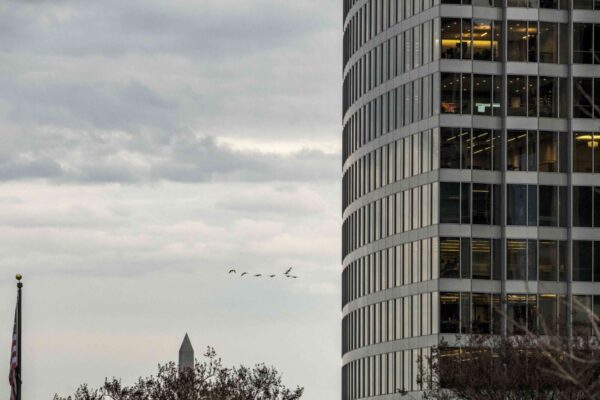
The following in-depth local reporting was supported by the ARLnow Press Club. Join to support local journalism and to get an early look at what we’re planning to cover each day.
When a member of Arlington County’s climate change committee took the dais earlier this month, she told the Planning Commission that she had good and bad news.
After evaluating the environmental commitments from JBG Smith for its Americana Hotel redevelopment project, the Climate Change, Energy and Environment Commission (C2E2) gave the project a score of 64.
“Sixty-four is a terrible score but it’s one of the best scores we’ve given,” member Cindy Lewin said.
She commended JBG Smith for participating in national and local programs incentivizing sustainable projects, and, at her request, meeting with a coalition focused on decarbonizing buildings. But, she emphasized, the building will still use significant fossil fuels.
“Arlington County is not going to be able to meet its commitments to climate change, to carbon neutrality and to its [Community Energy Plan] and sustainability goals if we continue to approve so much development,” she said.
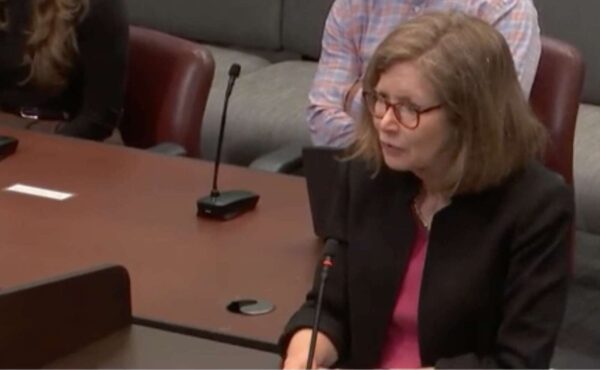
Arlington County, which has long been recognized nationally for its commitments to environmental sustainability, is trying to move away from fossil fuels. The burning of such fuels releases carbon into the atmosphere and contributes to a warming planet and other climate changes.
Since resolving in 2019 to neutralize its carbon emissions by 2050, Arlington County has already reached an important milestone toward that goal and knocked out other goals along the way.
In January — two years ahead of schedule — all county operations moved to renewable electricity, mostly because it is buying electricity from a new Dominion solar farm in rural Virginia. Arlington hired a first-ever Climate Policy Officer, purchased electric school buses and published the first edition of a quarterly publication showcasing its climate progress.
“Arlington, in general, is performing very well,” says Arlington County Board Takis Karantonis. “With what we set out to accomplish, we are at a nice level of completion.”
He says going forward, gains will be harder to achieve.
“We will have to electrify transportation and convince people not to drive so much,” he said. “We will have to make sure that new buildings are built at far higher standards than they were before.”
ARLnow spoke with leaders of a half-dozen environmental advocacy groups and every one of them commended the county — but said it is moving slowly and disjointedly toward electrifying everything from county buses to private development projects to single-family homes.
If it moved faster, they say, the county would live up to its reputation and show organizations and individuals these lifestyle and business changes are not only possible but necessary.
“What the scientific community is saying is that we have to cut carbon emissions by 50% by 2030 if we are to avoid going past what we need to to keep temperature rises at a manageable level,” C2E2 Chair Joan McIntyre said. “This is a critical thing we have to move quickly on and there’s a sense that that urgency is not seen in how the county is moving forward.”
These leaders hope the long-awaited climate czar, Climate Policy Officer Carl “Bill” Eger, will have the authority to steer a “whole of county” approach to reaching carbon neutrality. Julie Rosenberg, who leads the Arlington branch of Faith Alliance for Climate Solutions, says she has “ridiculously high expectations” for Eger.
“My hope is that he has staff and brings enthusiasm to decision-making and expectations so that it doesn’t feel like they look up and their bosses are so focused on getting the job done today,” she says. “I was a bureaucrat. It’s hard to run the train and envision a new path ahead but we have to do it. We don’t have a choice.”
In a conversation with ARLnow, Eger said some siloing is inevitable in local government but many divisions of Arlington’s government are working to solve problems collaboratively. His vision for a “whole of county” approach goes beyond the headquarters at 2100 Clarendon Blvd.
“As we look to the future, we are looking at a ‘whole of community’ thinking,” he said. “The county is the trusted institution standing behind the foundation of the work, bringing up community foundations, neighborhood groups, institutions, nonprofits and universities, to bring together resources and creativity, ways of problem solving and embedded intelligence to work toward contributing to solving climate change.”
He says his first aim is to integrate climate into policy conversations the way the county evaluates equity in its major policy discussions so it remains top-of-mind for the government.
As work continues on a new Arlington Transit bus facility in Green Valley, Arlington is taking steps to make it work for electric buses.
Electrifying buses is part of the county’s goal to reach carbon neutrality by 2050. To reach that goal, it needs to buy battery-powered electric buses and have a place to charge them.
Construction is currently set to wrap up next fall on a new ART Operations and Maintenance Facility at 2629 Shirlington Road and the county aims to have electric buses on-site by 2025. Meanwhile, Arlington is testing out different buses to see which to add to its fleet, piloting buses from two providers last year and possibly testing some from up to two more manufacturers.
With work progressing on both these fronts in tandem, plans for the facility moved forward with partially baked designs for charging infrastructure. This has set the county up to need to amend its design and construction contracts associated with the $96.6 million project as it learns more about what it needs to build.
This weekend, the Arlington County Board is set to tack on almost $585,000 to an existing $4.5 million design contract with Stantec Architecture to fully flesh plans to add up to 46 charging stalls that can accommodate up to 63 buses.
“As [Battery Electric Bus] concept plans were developed, the County proceeded with the 60% design for BEB charging infrastructure,” Dept. of Environmental Services spokeswoman Alyson Jordan Tomaszewski said. “The design scope expanded as the 60% design progressed and as more details about the County BEB requirements were identified.”
Once these designs are 100% complete, the county will update its construction contract with Turner Construction, authorizing it to purchase and install the charging equipment needed for the initial BEB pilot program, per a county report.
“The 100% design will provide capacity to add additional charging cabinets and equipment when additional BEBs are purchased,” it says.
Right now, something of a placeholder contract says the contractor has up to nearly $11.9 million to spend on above-grade charging equipment.
“This includes the necessary switchgear, transformers, chargers, and associated equipment to charge an initial increment of electric buses,” per a 2022 report. “It also includes canopies and solar panel over the canopies.”
That sum is on top of the $66.4 million contract to build the facility and below-grade charging infrastructure. These plans were approved with the expectation that the county would be buying electric buses sometime this spring.
While operating electric buses from the facility seems to have long been the plan, some neighbors had advocated for more fully baked plans for charging capabilities when the project was being developed.
Instead, designs stayed vague “to accommodate future fleet electrification” but be flexible enough to incorporate future technology, per a 2021 community presentation.
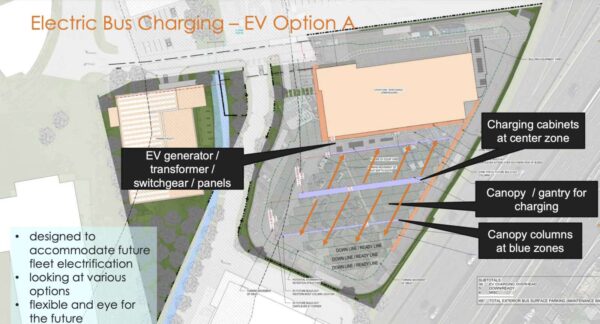
Construction on the facility continues apace and the county is still targeting a fall 2024 completion, Tomaszewski said.
“The erection of the steel structure on the Operations and Maintenance building was completed on March 17,” per the website. “In the next few weeks, crews will work on completing detailing of the steel, placing the metal deck, and completing the roof screening wall.”
Construction started last year, with a groundbreaking in June.
Buses are temporarily being stored on a property across the street from Washington-Liberty HIgh School, near a collection of homes. The county and some residents are embroiled in a lawsuit about whether the operations have impacted their quality of life.
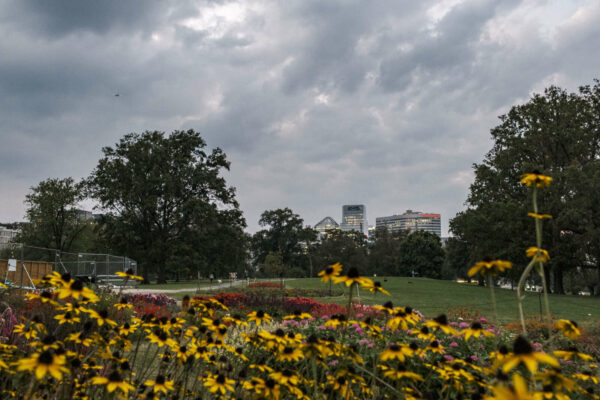
Arlington has ranked among the 15 most “eco-forward cities and towns” in the nation.
Specifically, Arlington is No. 5, behind No. 1 Somerville, Mass. and No. 3 Jersey City, N.J. (The latter being, arguably, Arlington’s New York metro area doppelgänger and long-time rival in various rankings.)
The list was compiled by Opendoor, the online home-buying company that you might receive frequent solicitous letters from if you own a house in Arlington. The company’s methodology looked at factors like bicycle parking, bicycle rentals, bicycle shops, electric vehicle charging, recycling, transit, second hand shops and the local government’s sustainability efforts.
How's the County been doing on climate progress? Take a look. https://t.co/UmySmccpCE pic.twitter.com/1Oo50efdqT
— Arlington Department of Environmental Services (@ArlingtonDES) April 11, 2023
“The cities and towns on our list, like Arlington, are putting a concerted effort into making eco-minded practices and solutions the norm, and specifically, Arlington is the first LEED Platinum certified community and is recognized as a leader in creating a sustainable environment,” Jennifer Patchen, a real estate broker for Opendoor, said in a statement. “Arlington has a long-proven success in reducing greenhouse gas emissions, and home buyers looking to plant roots in a ‘green’ community should consider Arlington.”
An Opendoor PR rep also noted: “78% of U.S. consumers say a sustainable lifestyle is important to them and that they’re prioritizing eco-conscious details and design in their home.”
The full list is below.
-
Somerville, MA
-
Emeryville, CA
-
Jersey City, NJ
-
Boulder, CO
-
Arlington, VA
-
Portland, OR
-
West Hempstead, NY
-
Carrboro, NC
-
Salt Lake City, UT
-
Santa Monica, CA
-
Temple Terrace, FL
-
Fort Collins, CO
-
Dearborn, MI
-
Phoenix, AZ
-
San Diego, CA
In addition to homeowners, Arlington’s eco bonafides have been a draw for employers.
In 2018, prior to Amazon’s HQ2 announcement, we famously reported that an internal Amazon webpage was sending thousands of views to an ARLnow article headlined “County Wins Top Environmental Award from U.S. Green Building Council.”
(Updated at 4:35 p.m.) Tree canopy in Arlington County is lower than it was in 2016, according to a new privately-funded study paid for local residents.
The residents, who are involved in Arlington County Civic Federation, Arlington Tree Action Group and EcoAction Arlington, funded the study to how much tree canopy declined since the last county study in 2017.
Based on imaging from 2021, a consultant found that trees cover 33% of land — excluding the Pentagon and Reagan National Airport — down from 41% on the same land six years ago. Coverage ranges by civic association, from 14% in Crystal City to 66% in the county’s northernmost neighborhood of Arlingwood, compared to 26% and 75%, respectively, in 2011.
“It’s really eye-opening,” one of the residents behind the study, Mary Glass, tells ARLnow. “Ideally, the county would have had this, but they didn’t.”
The tree lovers commissioned the study out of frustration with the county for not doing so before beginning work on a Forestry Natural Resource Plan (FNRP).
This updates a 2004 Urban Forest Master Plan and a 2010 Natural Resources Management Plan in one document to address climate change, population growth and threats such as diseases and invasive species, says Dept. of Parks and Recreation spokeswoman Jerry Solomon. It has an eye toward racial equity and environmental justice, to make sure all residents benefit physically and mentally from Arlington’s natural resources.
Combining the plans “allows us to consider Arlington’s ecosystem holistically and craft a more comprehensive set of recommendations for conservation and resource management in the future,” Solomon said.
During this process, and during the Missing Middle housing discussions that concluded with zoning updates earlier this month, preserving trees from redevelopment was mentioned as a top priority for many residents. (The zoning changes approved by the County Board specifies requirements for shade trees on properties redeveloped with Missing Middle housing.)
To help, volunteers from Marymount University and EcoAction Arlington have been planting trees in the hotter, less leafy parts of Arlington.
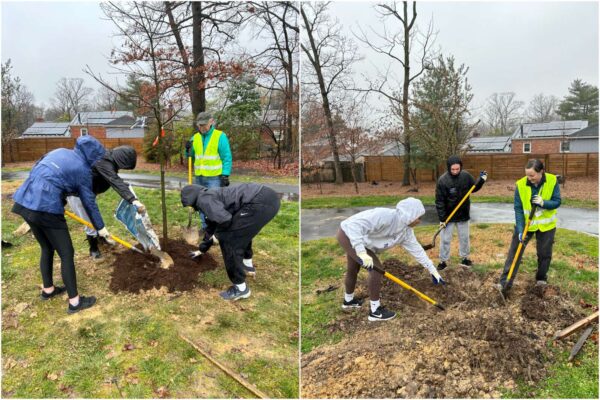
Now, Glass says, she hopes people will use the new data when the next Forestry Natural Resource Plan draft is published and ready for community input.
“This information is going to be right there so when the next draft comes out, in the next month or so, we’ll be able to make specific comments and recommendations based on the information we have,” Glass said.
The draft could be ready for community feedback this spring or early summer, Solomon said. The parks department spokesperson added that staff have seen the new study and “are excited about the community’s enthusiasm for our urban forests.”
However, she added, “we have not seen the underlying data and don’t have a full understanding of the methodology. As a result, we cannot speak to any discrepancies without adequately assessing it for accuracy, margin of error, or underlying assumptions.”
The department said it felt comfortable starting the plan update based on the overall downward trends in the previous tree canopy studies. Solomon said the current draft acknowledges and has recommendations for reversing the decline in tree canopy.
Despite marginal fluctuations, from a high of 43% in 2008 to a low of 40% in 2011 and a slight uptick to 41% in 2017, the county says tree coverage in parks is offsetting declining tree coverage on residential properties.
“Knowing this, we decided to prioritize the update of the FNRP in order to identify strategies to reverse that trend and address other environmental challenges sooner rather than later,” she said. Read More
Sponsored by Monday Properties and written by ARLnow, Startup Monday is a weekly column that highlights Arlington-based startups, founders, and local tech news. Monday Properties is proudly featuring 1515 Wilson Blvd in Rosslyn.
Zero waste delivery service The Rounds is continuing to expand its reach into Arlington with another zip code eligible for direct-to-door deliveries.
This week, the startup announced delivery will serve residents in the 22202 zip code, which covers Pentagon City, Crystal City, Aurora Hills and Arlington Ridge.
The expansion comes after the company tested this market with two pick-up locations it opened last year Movement Crystal City (1235 S. Clark Street) and Alexandria’s Sportrock Climbing Centers (5308 Eisenhower Ave). It also offers pick-up from Compass Coffee in Rosslyn (1201 Wilson Blvd).
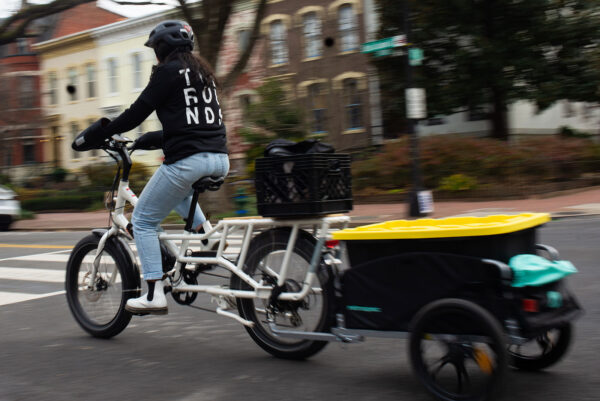
In addition to the 22202 zip code, The Rounds delivers to the 22201, 22207 and 22203 zip codes.
Following a $38 million fundraising round last fall, The Rounds announces it is adding produce to its offerings for residents in the D.C. area. Customers can now buy seasonal fruits and vegetables from 4P Foods, a community-shared agriculture company that sources produce directly from local farmers and serves the D.C. area.
After launching in Philadelphia in 2019, the zero-waste delivery service launched in D.C. in late 2021, offering residents “an easy, simple way to live more sustainably” when they purchase staples for their kitchens and cleaning closets, per the press release.
“Based on the traditional ‘milkman’ model, the company delivers all your household essentials — groceries, pantry, household, personal care, pet, and baby products — directly to your door, with no packaging waste,” the company said in a release. “They do this by putting everything in reusable containers and then picking up and reusing your empty containers on a weekly basis.”
Memberships cost $10 per month, plus the price of the products. The brand advertises no delivery fees or other “hidden” fees. People who sign up can customize products and receive their first delivery as soon as next week.
Four privately owned trees of “outstanding size” in Arlington could be protected from future removal or injury.
The owners, who live in the Williamsburg, Cherrydale and Glencarlyn neighborhoods, nominated these trees to be recognized as “specimens” worthy of protection, the county says in a report.
The trees meet criteria for this designation “by virtue of their outstanding size and quality for their particular species,” the report says. The Arlington County Board is set to grant this protection at its meeting this coming Saturday.
Over two decades ago, the Board approved a tree preservation ordinance that provides a four designations — “Heritage, Memorial, Specimen and Street Trees” — through which trees on public or private property can be protected from removal or injury. Some 17 trees are highlighted on the county’s website for their size, condition and heritage.
There are approximately 755,000 trees in Arlington, according to a draft of an update to the county Forestry and Natural Resources plan. The county controls about 120,000 trees, including those in parks and about 19,500 street trees. The remainder grow on private property or on public institutions that are not directly managed by Arlington County.
Protecting private trees is one strategy the county has for maintaining its canopy. For about as long as this ordinance has been in place, and despite redevelopment on private property, tree canopy has covered about 41% of land area in Arlington.
“This level of canopy has remained constant for the past 20 years, largely because significant losses on private property were offset by tree planting and preservation on parks and other public lands,” the plan says.
Arlington will have to rely more on designating and preserving trees, like the four going before the County Board this weekend, going forward, per the plan.
“With little ‘plantable space’ remaining on existing county-owned land, opportunities to offset future losses will be limited by the need to conserve natural areas,” it says.
Trees play an important role in reducing carbon, energy use and runoff.
Tree branches, roots and trunks remove and store about 9,360 tons a year of carbon in Arlington, but that represents “only a fraction of the County’s greenhouse gas emissions,” the plan says.
Tree canopy provides shade, reducing energy use in buildings and transportation and preventing the radiation of heat back into the environment. A recent study found leafier — and often wealthier — Arlington neighborhoods are cooler than its Metro corridors and lower-income areas, a disparity a local nonprofit is working to address.
Tree roots hold soil in place, reducing runoff during rain storms. Since a deluge in 2019 caused extreme flooding, there has been increasing focus on county stormwater infrastructure, as well as concern that trees are lost due to the redevelopment of older homes into larger homes that cover more of a given lot.
Dozens of Arlington Public Schools students now hop aboard the system’s first electric school buses.
When students returned from winter break, the county and APS replaced two of its 190 diesel engine buses with emissions-free “and almost noise-free” battery-powered electric ones, the county has announced.
The first two buses are transporting students with disabilities and can each carry up to 38 students. They are expected to log a typical 8,000 miles annually.
After the buses arrived in November, drivers and mechanics received vendor training. The third bus is expected to arrive by the end of January.
“Officials will study data, driving and service experiences with the new vehicles to explore possible expansion of the [battery electric school buses] inventory,” per the county press release.
The buses were purchased with a $795,000 state grant awarded in 2021. As part of the Clean School Bus Program, 19 Virginia districts were awarded with enough funding to replace a total of 83 diesel buses with electric or propane ones.
“Funding for the grant comes from the Volkswagen (VW) Environmental Mitigation Trust, intended to provide the state with about $93 million to mitigate the excess nitrogen oxide emissions caused by VW’s use of illegal emissions testing defeat devices in certain VW diesel vehicles,” the county said in a press release announcing the funding in August 2021.
The Arlington Dept. of Environmental Services Equipment Bureau services the school system’s fleet of vehicles as well as the county government’s entire fleet, from the Trades Center in Shirlington.
“The County is recognized as a leader in environmental sustainability efforts,” it said in its announcement. “This month, Arlington announced it had achieved its goal of 100% renewable electricity use at all County facilities, two years ahead of schedule.”
Arlington County adopted in 2019 a Community Energy Plan that aimed to power all county facilities with renewable electricity by 2025. Now, it has two more goals to tackle: By 2035, the county aims to power 100% of Arlington’s electricity with renewable sources, and by 2050, the county aims to be carbon neutral.
A year into new stormwater requirements for single-family home projects, homebuilders and remodelers say even the improved process is laborious and expensive, costing homeowners extra money.
On the other hand, Arlington County says that permit review times have shortened and that the program will be evaluated for possible improvements.
Before September 2021, builders had to demonstrate that a given property had ways to reduce pollution in stormwater runoff to comply with state regulations aimed at cleaning up the Chesapeake Bay.
Last year, the county began requiring projects that disturb at least 2,500 square feet of land to demonstrate the redeveloped property can retain at least 3 inches of stormwater during flash flooding events through features such as tanks, planters and permeable paver driveways. Builders must also refurbish the soil with soils that increase water retention.
Arlington Dept. of Environmental Services spokesman Peter Golkin says improvements like these “are vital as we continue the work toward a flood resilient Arlington,” especially as “the pace of single family home construction in Arlington remains strong.”
But the regulations are fairly new and could change, Golkin said.
“The first projects in LDA 2.0 are now coming to construction, and the County is entering the phase of evaluation to identify potential adjustments and improvements,” he said. ”The County expects to have more information about any LDA 2.0 updates by mid-2023.”
The updates were intended to address increasing infill development and rainfall intensity, and the downstream effects of runoff and impacts to the county’s aging storm drains and local streams.
Builders and remodelers say the changes have caused new headaches and resulted in projects shrinking in size.
“It only gets more complicated, costs more, and takes longer,” says architect Trip DeFalco.
Andrew Moore, president of Arlington Designer Homes, said he’s avoided this process in many projects after telling the clients about the potential costs and permitting time.
“People are motivated to think, do I need that bump-out to be 14 feet? I can live with 12 feet,” he said. “It saves you $50,000 and 3 months.”
Despite the hassle, permit applications are still coming in at a clip of, on average, 20 per month.
Responding to redevelopment
In the wake of the destructive July 2019 flash flood, residents has discussed and voted on ways to address stormwater mitigation in Arlington, while the county has put more funding toward stormwater improvement projects.
The issue of runoff has figured into debates about how to protect streams and the impacts of allowing the construction of two- to eight-unit “Missing Middle” houses in Arlington, though such projects could only occupy the footprint currently allowed for single-family homes on a given property.
In the wake of the flash flooding, the county introduced new regulations for what it says is one of the biggest runoff contributors: new single-family homes.
“Ensuring more robust control of runoff from new single family homes, which create the majority of new impervious area from regulated development activity, remains a top County priority as part of the comprehensive Flood Resilient Arlington initiative,” Golkin said.
An average of 167 single-family homes have been built and an average of 155 torn down annually over the last 11 years, according to Arlington’s development tracker tool. Demolitions peaked in 2015 and completed projects in 2016.
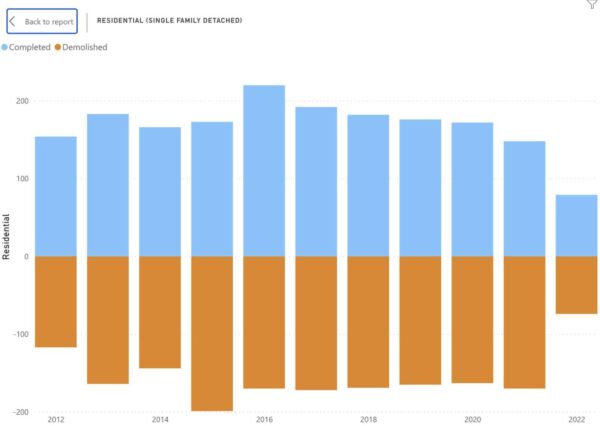
A past of pollution
DeFalco, who spent a few years as a builder, too, says the “county’s hands are a little bit tied” on this issue because they have to meet state requirements aimed at curbing pollution in the Chesapeake Bay.
Runoff brought fertilizer into the bay, causing algae and plants to grow quickly and then die, sink to the bottom, where they decayed and used up oxygen, says civil engineer Roger Bohr.
“The state is pushing on the county and the federal government is pushing on the state,” DeFalco said. “But the implementation on the homeowner level is pretty onerous… I don’t think the residents have any idea what’s going in their side yards.”
Golkin compared the transition period right now to when new state stormwater management requirements took effect in 2014.
“Staff and the building and engineering community ultimately came up to speed,” he said.
Sponsored by Monday Properties and written by ARLnow, Startup Monday is a weekly column that highlights Arlington-based startups, founders, and local tech news. Monday Properties is proudly featuring 1515 Wilson Blvd in Rosslyn.
A startup that bills itself as a “modern-day milkman” is deepening its reach in Arlington after securing $38 million in new funding.
The Rounds delivers home essentials, like cleaning supplies, and goods from local companies such as D.C.-based Compass Coffee and Seylou Bakery, in reusable or sustainable packaging. On the same day of each week, members swap their empty containers for replenished products.
After launching in Philadelphia in 2019, The Rounds expanded into D.C., Virginia and Miami over the last year. Today, it serves about 10,000 members, according to a blog post announcing the funding.
The Rounds will be expanding its reach first via pick-up at two locations in Arlington: Compass Coffee in Rosslyn (1201 Wilson Blvd) and Movement Crystal City (1235 S. Clark Street). Pick-up is also available from Alexandria’s Sportrock Climbing Centers (5308 Eisenhower Ave).
“Pickup locations are usually what we start out with in new zip codes where we’re still building up a Member base and setting up our refillment centers in that location, so we usually lean on them as we’re getting set up and then transition to at-door delivery when we can support it,” says Nikhita Prasanna, the chief of staff at The Rounds.
The Rounds is now offering a pick-up option for Arlington residents living in the 22202, 22211, 22213, 22214, 22203, 22204, 22205 and 22206 zip codes, Prasanna says. For now, it’s only delivering to residents in the 22201, 22207 and 22203 zip codes.
As for why The Rounds has chosen climbing gyms, she says that is because a lot of its target audience climbs recreationally.
“When we started doing events at climbing gyms, we noticed that people were super excited about The Rounds and regularly came to the climbing gym as part of their weekly routine,” she tells ARLnow. “So, we worked with our climbing gym partners to set up pickup spots so that when Members come to do their climbing, they can also get refilled. We’re not limited to climbing gyms as the only pick-up spots, but we’ve found that the climbing community tends to be mission-aligned and excited about our service.”
The chief of staff said her team hopes to begin at-door deliveries in these eight Arlington zip codes next year.
That effort could get a boost from an upcoming zoning change. Arlington County may soon allow micro-fulfillment centers as an alternative use for vacant office units, as a way to bring down its 20.8% office vacancy rate and meet an increasing delivery demand.
While Prasanna couldn’t speak to the work the operations team may be doing on this locally, she said that is likely “something we’re exploring to allow us to better serve Arlington residents.”
Meanwhile, The Rounds is looking for more apartment buildings with which to partner.
“We already work with a number building partners in Arlington, and we’re looking to expand partnerships,” she said. “If any reader is excited about our concept and lives in a building they think would be willing to partner, we would love any leads. We’re actively working on building partnerships right now.”
The startup is also planning to use the funding to improve the technology it uses to predict when customers need refills, or its “Psychic Home Manager.”
“We’re able to use technology to build a predictive engine that allows us to anticipate what you need before you run out,” said co-founder Alex Torrey in a statement.
Additionally, The Rounds announced that it is partnering with a tech startup started by General Motors, called BrightDrop, to test out delivery via electric vehicles.
The funding — led by private equity company Redpoint Ventures and venture capital company Andreesen Horowitz — follows a $4 million round of seed funding, per the blog post.



